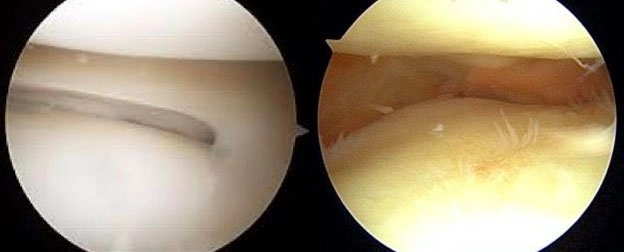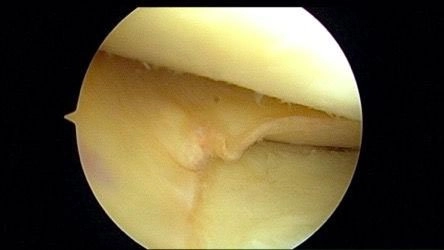
Why perform meniscal transplant surgery?
Meniscal deficiency increases the contact pressures by 235-335% on the articular cartilage within the knee, predisposing the knee to early onset osteoarthritis. Unstable, or progressive meniscal tears in younger patients puts them at higher risk of degenerative knee disease. My preferred treatment method is to repair the existing meniscus, but sometimes, the meniscus is too worn so we must consider meniscal transplant.


Arthroscopic views during meniscal transplant surgery
Who is appropriate for meniscal transplant surgery?
The ideal candidate for meniscal transplantation is a younger patient who does not have features of osteoarthritis yet. These patients tend to have pain due to meniscal deficiency, and other treatment methods such as meniscal repair and non-operative measures have been trialled. In these circumstances, meniscal transplantation can be very successful.
What is involved in meniscal transplant surgery?
An MRI scan of your knee is used to determine the appropriate size and shape of the transplanted tissue. I then ‘match’ the required size and shape with available donor tissue, to determine an appropriate fit. The donor tissue must come from a reputable ‘tissue bank’, much like a blood bank. The ideal tissue is sterilised to prevent infection, but importantly not ‘irradiated’ as it damages the cells within the donor tissue affecting its function.


Arthroscopic view of a transplanted meniscus
Once a suitable match is found, surgery can proceed. Surgery is performed arthroscopically, via ‘keyhole’ surgery. This reduces post-operative pain, allowing patients to be discharged after only one night in hospital. The transplanted meniscus is introduced into the knee in the correct orientation, and then fixed to the bone and the joint capsule via sutures and anchors, to stabilise the transplanted tissue.
Post-operative care for meniscal transplant surgery
Recovery from meniscal transplant surgery is lengthy. Each surgery is specific, so recovery timeframes can vary. However, most patients can expect to use crutches for 6-8 weeks, with the use of a hinged knee brace during this time. The earliest stages of recovery focus on reduction of swelling, range of motion and pain relief.
Most patients are confident with their new meniscus by 6 months, with complete recovery taking up to 1-year post operatively.
If you are considering having meniscal transplant surgery, please make an appointment to discuss your treatment options.



